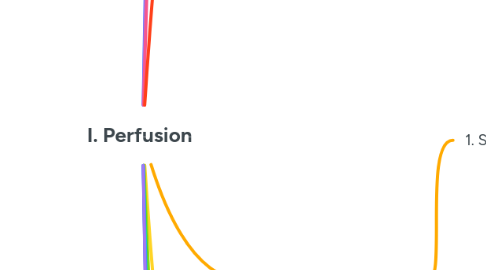
1. A. Definition and Importance
1.1. 1. Adequate blood flow to deliver oxygen and nutrients to tissues
1.2. 2. Critical for organ function and overall homeostasis
2. A. Hypovolemic Shock
2.1. 1. Signs and Symptoms
2.1.1. a. Tachycardia
2.1.2. b. Hypotension
2.1.3. c. Cold, clammy skin
2.1.4. d. Decreased urine output
2.1.5. e. Confusion
2.2. 2. Laboratory Findings
2.2.1. a. Elevated lactate levels
2.2.2. b. Low central venous pressure (CVP)
2.2.3. c. ↑ Hematocrit (in hemorrhagic shock)
2.3. 3. Examples
2.3.1. a. Trauma
2.3.2. b. Gastrointestinal (GI) bleed
2.3.3. c. Dehydration
3. B. Cardiogenic Shock
3.1. 1. Signs and Symptoms
3.1.1. a. Hypotension
3.1.2. b. Chest pain
3.1.3. c. Pulmonary edema
3.1.4. d. Weak pulse
3.1.5. e. Cool extremities
3.1.6. f. Distended neck veins
3.2. 2. Laboratory Findings
3.2.1. a. Elevated troponin levels
3.2.2. b. Elevated brain natriuretic peptide (BNP)
3.2.3. c. Echocardiogram showing reduced ejection fraction
3.3. 3. Examples
3.3.1. a. Myocardial infarction
3.3.2. c. Valvular heart disease
4. C. Distributive Shock
4.1. 1. Subtypes
4.1.1. a. Septic Shock
4.1.2. c. Neurogenic Shock
4.2. 2. Signs and Symptoms
4.2.1. a. Septic Shock:
4.2.1.1. i. Hypotension
4.2.1.2. ii. Warm, flushed skin
4.2.1.3. iii. Tachycardia
4.2.1.4. iv. Fever
4.2.2. b. Anaphylactic Shock:
4.2.2.1. i. Hypotension
4.2.2.2. ii. Tachycardia
4.2.2.3. iii. Rash and swelling
4.2.2.4. b. Severe arrhythmia
4.2.3. c. Neurogenic Shock:
4.2.3.1. i. Hypotension
4.2.3.2. ii. Bradycardia
4.2.3.3. iii. Warm skin
4.3. b. Anaphylactic Shock
4.4. 3. Laboratory Findings (Primarily for Septic Shock)
4.4.1. a. Elevated lactate levels
4.4.2. b. Positive blood cultures
4.4.3. c. Elevated procalcitonin levels
4.4.4. d. Low systemic vascular resistance
4.5. 4. Examples
4.5.1. a. Sepsis from infection
4.5.2. b. Severe allergic reaction (anaphylactic)
4.5.3. c. Spinal cord injury (neurogenic shock)
5. D. Obstructive Shock
5.1. 1. Signs and Symptoms
5.1.1. a. Hypotension
5.1.2. b. Distended neck veins
5.1.3. c. Muffled heart sounds
5.1.4. d. Dyspnea
5.2. 2. Laboratory and Imaging Findings
5.2.1. a. Elevated CVP
5.2.2. b. Echocardiogram (e.g., cardiac tamponade)
5.2.3. c. CT scan (e.g., pulmonary embolism)
5.3. 3. Examples
5.3.1. a. Cardiac tamponade
5.3.2. b. Tension pneumothorax
5.3.3. c. Massive pulmonary embolism
6. A. Iron Deficiency Anemia
6.1. 1. Signs and Symptoms
6.1.1. a. Fatigue
6.1.2. b. Pallor
6.1.3. c. Shortness of breath
6.1.4. d. Brittle nails
6.2. 2. Laboratory Findings
6.2.1. a. Low hemoglobin and hematocrit levels
6.2.2. b. Low serum iron and ferritin
6.2.3. c. High total iron-binding capacity (TIBC)
6.2.4. d. Microcytic, hypochromic red blood cells (RBCs)
7. B. Megaloblastic Anemia (Vitamin B12/Folate Deficiency)
7.1. 1. Signs and Symptoms
7.1.1. a. Fatigue
7.1.2. b. Pallor
7.1.3. c. Glossitis
7.1.4. d. Neurological deficits (especially if B12 deficient)
7.2. 2. Laboratory Findings
7.2.1. a. High mean corpuscular volume (MCV)
7.2.2. b. Low vitamin B12 or folate levels
7.2.3. c. Hypersegmented neutrophils
8. C. Hemolytic Anemia
8.1. 1. Signs and Symptoms
8.1.1. a. Jaundice
8.1.2. b. Dark urine
8.1.3. c. Splenomegaly
8.1.4. d. Fatigue
8.2. 2. Laboratory Findings
8.2.1. a. Increased lactate dehydrogenase (LDH)
8.2.2. b. Increased indirect bilirubin
8.2.3. c. Decreased haptoglobin
8.2.4. d. Reticulocytosis
8.3. 3. Example
8.3.1. a. Sickle cell anemia
9. D. Anemia of Chronic Disease
9.1. 1. Signs and Symptoms
9.1.1. a. Fatigue
9.1.2. b. Pallor
9.2. 2. Laboratory Findings
9.2.1. a. Normocytic or microcytic RBCs
9.2.2. b. Low serum iron
9.2.3. c. Low TIBC
9.2.4. d. Normal or high ferritin
10. A. In Shock
10.1. 1. Decreased tissue oxygenation due to circulatory failure
10.2. 2. Manifestations include:
10.2.1. a. Hypotension
10.2.2. b. Tachycardia
10.2.3. c. Confusion
10.2.4. d. End-organ damage
